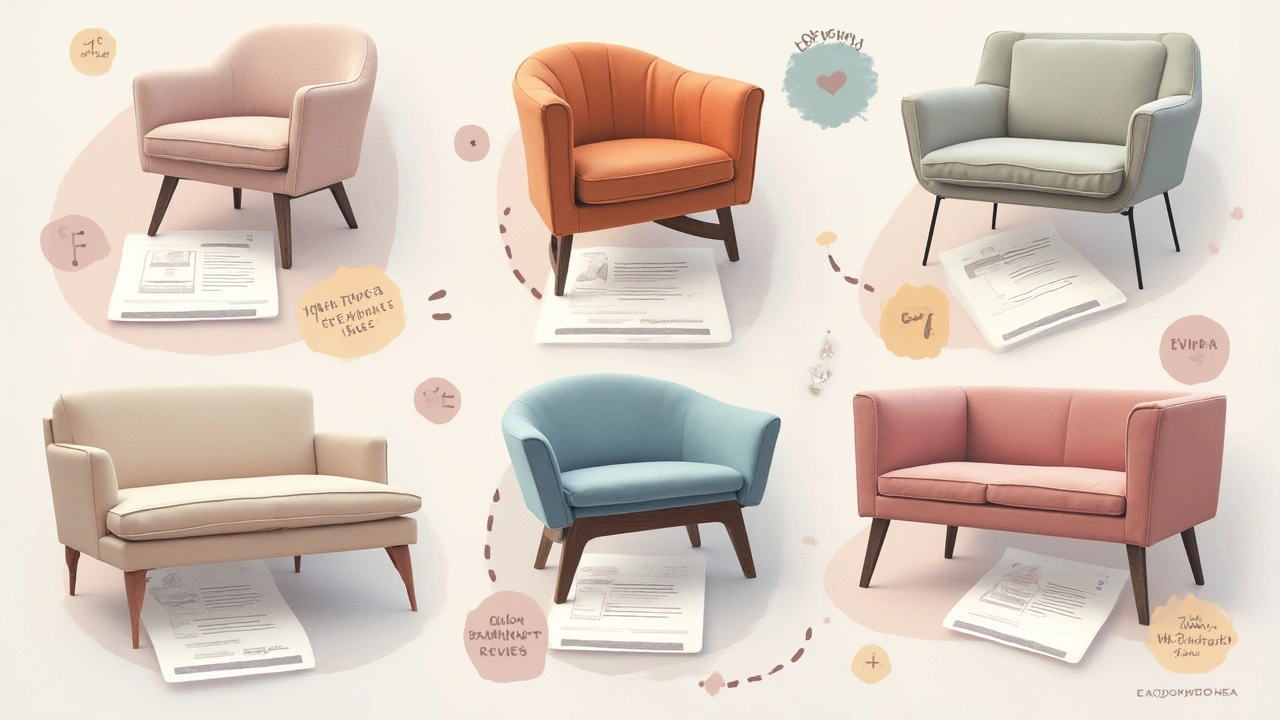Best Sites for Furniture: Where to Shop Online for Every Style and Budget
 Jun, 15 2025
Jun, 15 2025
Buying furniture online used to feel like a gamble, but now? There are tons of sites out there offering everything from cheap basics to fancy, one-of-a-kind pieces. The trick is figuring out which ones are actually worth your time and cash. Ever waited four months for a sofa only to realize you hate the color? Yeah, me too. That’s why it pays to know where to shop before clicking 'add to cart.'
If you're hunting for a place where prices make sense and the photos actually match what shows up at your door, you’re in the right spot. I’ll break down what to look for in a good furniture website (think: return policy, reviews, shipping), which brands everyone talks about (and if they’re actually worth it), plus some lesser-known sites for people who want their place to stand out. I’ve picked up a few tricks after buying kid-proof couches and grown-up bedroom sets, so you’ll get some concrete tips for scoring deals and avoiding disasters.
- What Makes a Good Furniture Site?
- The Big Names Everyone Knows
- Hidden Gems for Unique Pieces
- Saving Money and Avoiding Headaches
- How to Shop Like You Know What You're Doing
What Makes a Good Furniture Site?
All furniture sites claim they’re the best, but some make shopping way easier than others. You want a site that’s not just about flashy photos. There are key details that separate a solid shop from one that’ll leave you with buyer’s remorse.
- Clear product info: You should see close-up photos, dimensions, real material details, and how to clean or build it. Sites like Wayfair and Article show actual photos from customers, which helps spot cheap knockoffs from quality pieces.
- Transparent shipping and returns: No one wants to pay $200 for delivery or get stuck with a chair that doesn’t fit. Good sites stamp their shipping costs up front and keep return policies straightforward. West Elm and IKEA spell this out before checkout, and that saves headaches later.
- Trusted customer reviews: Look for reviews that mention what the furniture is like after months, not just first impressions. If a site buries or filters reviews, that’s a red flag. Amazon and Target usually show the good, the bad, and the ugly.
- Fair prices and deals: Some sites hike up prices, hoping you won’t notice. The best ones run real sales, throw in free delivery, or offer package deals for basics (sofas or dining sets, for example). Keep an eye out for promo codes, which pop up a lot during back-to-school or holiday sales.
- Easy filters and search tools: If you’re shopping for kids and need a couch that's wipeable, good sites let you filter by things like stain resistance or fabric type. The huge stores like Overstock and AllModern make this simple, while some smaller stores are a pain to search.
It comes down to trust. A legit furniture site wants you to know exactly what you’re getting. If the site feels shady or makes it hard to find answers, that’s your cue to back out and try somewhere else.
The Big Names Everyone Knows
You can’t talk about buying furniture online without mentioning a few classic go-to sites. These are the places that pop up on everyone’s radar the second someone says, “I need a new couch.” The big names all have their perks, but there are differences that can save you time, money, or hassle—if you know what to look for.
Wayfair is practically the Amazon of furniture. It’s famous for its massive selection and non-stop flash sales. If you want options and you like scrolling through seemingly endless pages of products, this is your playground. You’ll find deals here, but check the reviews before you click buy—quality can jump all over the place, especially in the budget range. Shipping is usually free over $35, and they have a 30-day return policy, but return shipping is rarely free unless an item is damaged.
IKEA is still the king of affordability and that clean, modern vibe everyone from broke college kids to fully grown families (like mine) go for. Their furniture is usually in stock and ships quick, plus there’s a track record for durability (as long as you actually use the Allen wrench right). One thing to watch: assembly can be a headache, especially if your kids are running around while you’re deciphering the instructions. IKEA’s product names are still basically unsolvable, but the pictures help. Returns are easy—you get up to 365 days if things don’t work out.
Amazon has exploded into the furniture world, too. It’s great if you want fast shipping (especially as a Prime member), and the range is surprisingly big. Some name brands sell directly on Amazon, plus you’ll see smaller, cheaper brands. Use the filter tools to avoid digging through endless knockoff couches. Double-check furniture dimensions—sometimes things look big in the photo and show up looking like kid-sized toys.
Pottery Barn is the spot when you want your place to feel classic and put together. Quality is excellent, but prices are higher. The site has design ideas built right in, so if you’re not big on styling, you can basically copy whole rooms. The downside: Pottery Barn shipping can take weeks, and delivery fees can creep up. But they do offer free design services online.
Here’s a quick side-by-side to break down the basics:
| Site | Known For | Average Delivery | Return Policy | Special Tip |
|---|---|---|---|---|
| Wayfair | Big selection, sales | 1-3 weeks | 30 days (buyer pays return shipping) | Check reviews for quality |
| IKEA | Cheap, modern, in-stock | 2-14 days | 365 days | Prepare for DIY assembly |
| Amazon | Fast shipping, variety | 1-7 days (Prime) | 30 days | Double-check measurements |
| Pottery Barn | Classic style, great quality | 2-8 weeks | 30 days | Use the free design chat |
The big names have something for everyone, but they’re not perfect. Paying attention to all the small details—like shipping times, return fees, and who’s actually selling the product—can save you a lot of future headaches. And don’t skip the customer photos in reviews. Real-life living rooms don’t use professional lighting, so it’ll help you see what your new sofa will actually look like once it’s home—kids’ fingerprints and all.

Hidden Gems for Unique Pieces
If you want your place to look like nobody else’s, you’ve got to think beyond big box stores. There are some online shops out there that make it easy to find furniture with personality—stuff that stands out, not cookie-cutter sets.
First up, Etsy. Tons of sellers offer upcycled, vintage, and handmade furniture you won’t spot in your neighbor’s living room. You can message sellers about custom work, which is great if you want a coffee table in a weird color or a bed frame sized for your actual mattress (especially if your kid’s bunk bed needs are oddly specific—happened to me!).
Another favorite: Chairish. This site is packed with mid-century pieces, funky lamps, and vintage finds in every price range. It has search tools for color, size, and period (’70s orange is suddenly cool again), and sellers usually upload real, unfiltered photos. That helps avoid surprises when the box hits your porch.
If you’re hunting for unique deals and don’t mind gently-used stuff, AptDeco is worth a look. It connects people selling used furniture (think West Elm dressers or Restoration Hardware tables at a fraction of new). They even arrange delivery, which is a life-saver if you’re not into moving giant pieces with your own car.
Handmade, artisan stuff? Try Sagalaga. Not huge, but the site’s mostly small-batch makers, so everything feels intentional. The site even does quality checks on listings—pretty rare, honestly.
For folks in cities like NYC, LA, or Chicago, Furnishare lets you actually rent out unique pieces for a few months at a time. That’s huge if you want something cool for now but don’t want to commit forever (movers know the pain).
Here’s a quick snapshot of what makes these sites stand out:
| Site | Main Draw | Custom Options | Delivery Area |
|---|---|---|---|
| Etsy | Handmade, vintage, and custom work | Yes, direct with makers | Worldwide |
| Chairish | Mid-century, vintage, and designer resale | Some, varies by seller | US, some international |
| AptDeco | Used brand-name furniture, affordable prices | No | US (major cities) |
| Sagalaga | Artisan, small-batch pieces | Yes, curated makers | US |
| Furnishare | Furniture rental of unique items | No | NYC, LA, Chicago |
A tip for any of these: dove deep into the photos (close-ups help spot scratches), check return policies, and look for seller ratings. Most smaller or resale sites are way more open about imperfections than the big chains, which actually helps when you want that perfectly worn-in look. If you want your furniture to actually spark conversation, these off-the-beaten-path shops are the way to go.
Saving Money and Avoiding Headaches
No one wants to pay too much—or end up with a sofa that shows up looking totally different than it did in the pictures. Saving money on furniture online is possible, but only if you know what to watch out for and where to find the best deals.
First, always look for promo codes and sales. Most top sites like Wayfair, Overstock, and AllModern run weekly deals, especially around holidays and back-to-school season. Seriously, there’s rarely a good reason to pay full price. I’ve even used Honey or RetailMeNot browser extensions to snag an extra 10% off. Also, sign up for site newsletters just for the first-time customer discount, and then unsubscribe if they get spammy.
Check shipping costs before committing. Some retailers like IKEA offer surprisingly affordable flat-rate delivery, while others tack on sneaky fees at checkout. Free shipping over a certain amount is common, but the threshold can vary—Target and Amazon usually hit free shipping on orders over $35. Don’t get caught out by "White Glove Delivery" fees unless you really need someone else to carry everything in and assemble it for you.
It’s easy to focus on price, but returns are just as important. Not all sites have free return shipping. Amazon and Wayfair are usually no drama for returns, but smaller or trendier sites might charge for restocking—which can kill your savings fast. Always read the fine print before ordering anything big.
Here are some easy ways to keep your wallet and your stress level in check:
- Filter by price range and sort by customer ratings—even for cheap stuff, reviews spot the flimsy pieces fast.
- Check for real-life customer photos, not just staged ads. Amazon, Wayfair, and Article all let buyers upload these, and they can totally change your mind.
- Consider open-box or clearance sections. Sites like Overstock and even West Elm’s "Final Sale" page often carry returns or display items in perfect condition for a fraction of retail price.
- For big purchases, pay with a credit card for built-in purchase protection. Sometimes this can help if a site refuses a legit return or sends something damaged.
- If a price drops within a week or two after you buy, ask for a price adjustment. Some stores honor this, but not all—so it never hurts to try.
At the end of the day, the most important part of furniture shopping online is being prepared and a little skeptical. With these tips, you’ll stretch your dollar and dodge a few headaches along the way.

How to Shop Like You Know What You're Doing
I’ve learned the hard way that online furniture shopping isn’t rocket science, but it does take a bit of street smarts. If you don’t want to end up stuck with a wobbly bookcase or a couch that feels like a rock, here’s what pros and experienced shoppers actually do. No mystery, just good habits.
- Always Check Measurements: Don’t eyeball it. Grab a tape measure. Most returns happen because people misjudge the size—either it won’t fit through the door, or it swallows up half the living room. Sites have detailed size info in the specs section, so make a quick sketch or mark the floor with tape if you need to see it for real.
- Read Real Reviews, Ignore the Rest: Verified buyer reviews with photos tell the actual story. Skip the gushing, generic five-star ones. Pay attention to folks who mention assembly, comfort, and durability, especially if you have kids or pets climbing all over everything.
- Know the Return and Delivery Policy: Stuff happens—colors look different, or the quality isn’t there. Check if the site offers free returns, how long you have (usually 30–90 days is fair), and who pays for the shipping back. This is huge. One site reported that 35% of big-item returns are due to shipping damage alone.
- Compare Prices and Watch for Hidden Fees: The same sofa can cost $100 more on one site than another. Some places offer "free shipping" but bake the cost into the price. Others have weird delivery fees, so always get to the final checkout page to see the real total. Tip: Major deals drop around Memorial Day, Black Friday, and Labor Day in the U.S.
- Test the Materials (as much as you can): Look up swatch options—lots of sites send fabric samples so you don’t guess wrong. Solid hardwood lasts longer than particle board, and cushion fill (down versus foam) makes a big difference for comfort and longevity.
If you like numbers, here’s a quick comparison of what matters most for online shopping. This table’s based on retailer data and shopper surveys from late 2024:
| Factor | Importance (out of 10) | What to Look For |
|---|---|---|
| Size & Fit | 9.2 | Check product dimensions, entryways, layout |
| Reviews | 8.7 | Filter by recent, photo, detailed experiences |
| Return Policy | 8.3 | Free returns, easy process, clear time window |
| Delivery Fees | 7.5 | Transparent shipping costs, trackable delivery |
| Material Quality | 8.5 | Sample swatches, manufacturer details |
One last thing: use tools like augmented reality (AR) previews that some big-name sites offer. Apps can show you how that new coffee table will look in your actual room just by using your phone's camera. It's surprisingly handy for spotting style clashes and double-checking space. If the site you're shopping at doesn't offer this, you can always use painter's tape on the floor and some imagination. You’ll avoid those "oh no, what have I done?" moments when the delivery truck rolls up.